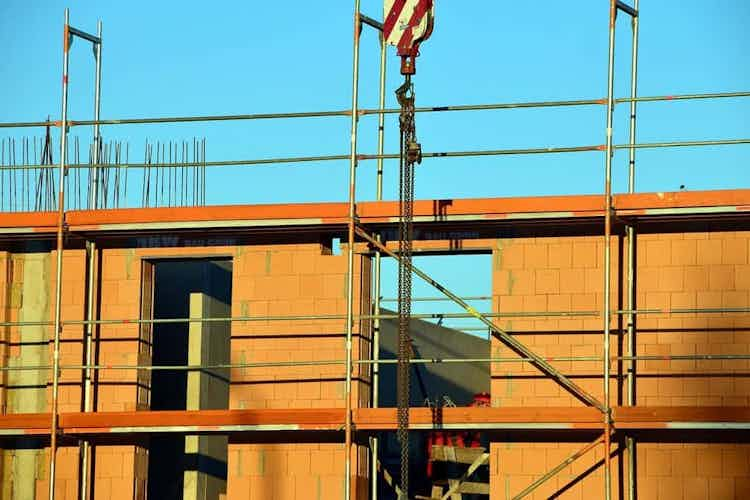The UK government recently announced plans to build 300,000 new homes each year by the mid-2020s. Unfortunately, we regularly hear of ambitious new build aspirations, but governments rarely deliver. As a consequence, the demand for new build properties in the UK continues to outstrip supply. This is one reason for the so-called new build premium, but there are other issues to consider.
What are the reasons behind a new build premium?
There are many reasons why housebuilders can charge a new build premium on their properties. These include:
- New properties are generally built to a much higher specification than older homes.
- All equipment in a new build property is unused.
- New build properties now come with a ten-year guarantee.
- In theory, a new home should be ready to move into with no decor changes required.
- Energy efficiency regulations ensure that new build properties are much more efficient.
When you look at the reasons for a new build premium, it begins to make sense. Unfortunately, akin to driving a brand-new vehicle out of the showroom, and experiencing a drop in value, this is the same for new build properties. However, the deflation of the new build premium tends to occur over several years.
What is the average new-build premium in the UK?
A recent report by the Property Industry Eye website cast a fascinating light on the average UK new-build premium. In August 2019 the average property in the UK was valued at £224,729. At the same time, the average price of a new build property in the UK stood at a staggering £290,176, a new build premium of 29%.
The same report included a breakdown of the nations of the UK as follows:
| Area of the UK | New build premium |
| Scotland | 41% |
| Wales | 36% |
| England | 27% |
| Northern Ireland | 25% |
The average cost of new homes and existing homes varies significantly across different areas of the UK. However, there are some reasonably hefty new build premiums in existence.
Even though 2020 has been very challenging for the UK property market, with COVID decimating the economy, we are unlikely to see a significant drop in the new build premium. This is due to strong demand for new build properties, even more short-term supply restrictions and an improving outlook on the UK economy, in light of successful Brexit negotiations.
Funding a new build property
The funding of new build properties, accommodating the new build premium, has prompted a degree of controversy. There are many issues to consider.
Help to Buy Scheme
Many experts believe the UK government's "Help to Buy" scheme has inadvertently affected new build property prices. Under the scheme, those looking to acquire new build homes outside of London can apply for up to 20% of the purchase price, in the form of a government loan. This is interest-free for five years. The maximum funding increases to 40% when acquiring a new build property in London.
Those looking to take advantage of the attractive terms of the “Help to Buy” scheme can only consider new build properties. This has skewed the supply-demand ratio, allowing developers to maximise their new build premiums.
Mortgage Loan to Value (LTV) ratio
When you consider the average UK new-build premium stood at 29% in 2019, this creates an added degree of risk for mortgage lenders. In theory, over the first few years of ownership, assuming no organic growth in property prices, the new build premium could start to deteriorate. Consequently, in the early years, the degree of loan cover provided by the property value could cause issues.
Therefore, it can be challenging to secure mortgage finance on an LTV ratio higher than 70%. Even buyers who take advantage of the government's "Help to Buy” scheme may still need to secure added deposit funding. It is essential to point out that some new build developments will retain their premiums better than others. In some cases, where demand remains relatively high, a new build property's value could even increase further.
Therefore, it is vital to take advice before acquiring a new build property so that you are fully aware of the potential financial risks.
Is it possible to retain a new build premium?
A report on the What House website provides some interesting research into new build premiums. Historical data suggests that:
- New build properties built in the 2000s retain twice as much of their new build premium than homes built in the 1990s.
- Some housing developments will experience erosion of the new build premium, spread over the first seven years of ownership.
- Circa 25% of new homes, which are part of high-quality developments, can retain their new build premium for many years.
- Smaller developments tend to retain their value advantage more successfully, due to a lack of downward pricing pressure. This pressure can often be an issue towards the end of some larger developments.
- On average, when a new build property is first resold, the new build premium will have fallen by 50%.
For the vast majority of those acquiring new build properties, the premium's erosion would be somewhere between the above extremes. If a particular area is experiencing strong demand for homes, the natural increase in property values may partly or wholly offset any erosion in the new build premium.
Cautious approach to new build properties
In reality, the potential to retain and even build on a new build premium will depend upon the property's quality and location. Erosion of the premium may seem relatively "gentle" if spread over seven years. However, that scenario assumes that house prices remain constant.
Properties acquired before a downturn in prices may suffer a double whammy. Economic and financial challenges would likely reduce demand for the property, perhaps increasing the rate at which the premium erodes. On top of this, a general reduction in property prices could see a significant decrease in the overall value of a relatively new home.
This is one of the reasons why mortgage lenders are cautious when providing finance for new build properties. You may also find that some new build mortgage lenders will charge a higher interest rate, to reflect the perceived increase in risk.
Buyers and investors will often express caution, too. A spokesperson for Landlord Vision told Pension Times: “For many, the premium on new builds is a firm argument for not investing in this type of property, but it does have benefits. In some areas, even with the premium applied, existing properties can sell for more than a new build property; however, these are few and far between.
"Those risk-averse investors who are environmentally conscious or those hoping to have lower maintenance costs may find new builds more attractive. Overall though, property investors are still less likely to purchase a new build because they generally have lower yields, less square footage, and diminished capital growth.”
New build properties are not without challenges
As we have detailed above, there are various financial issues to consider when acquiring new build properties. On a more positive note, all equipment in your home will be new, and you may even have some input on initial décor. There is also a ten-year guarantee and the fact the property will abide by new energy efficiency regulations. It is vital to take advice when looking to acquire a new build property to be fully aware of the pros and cons.








